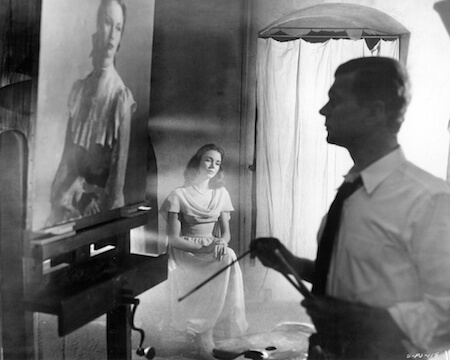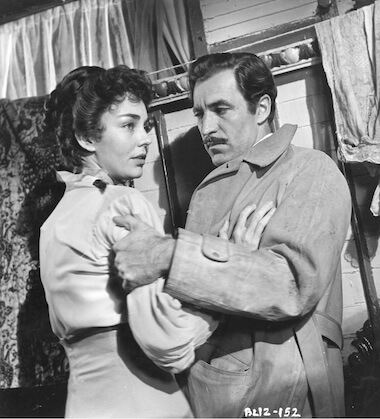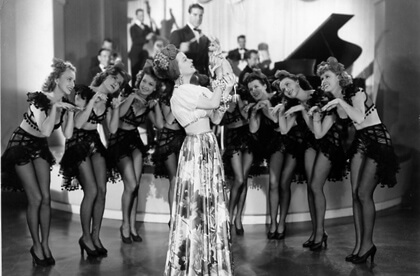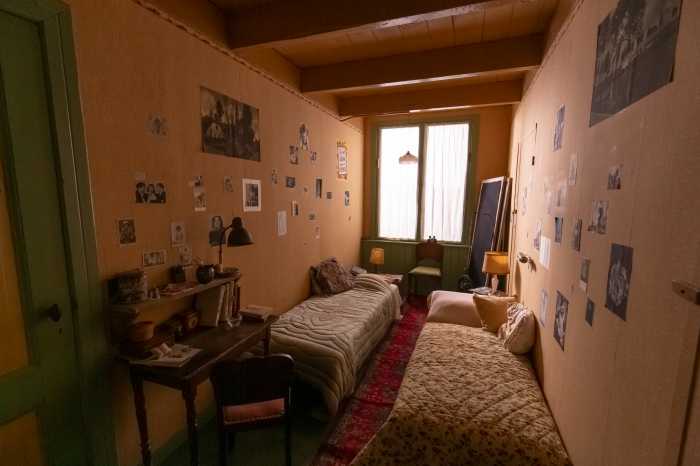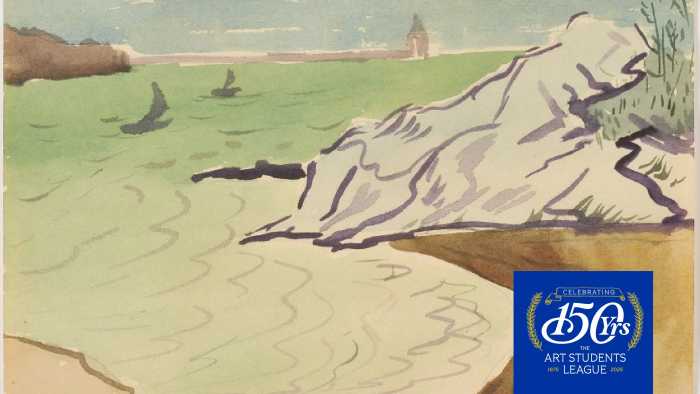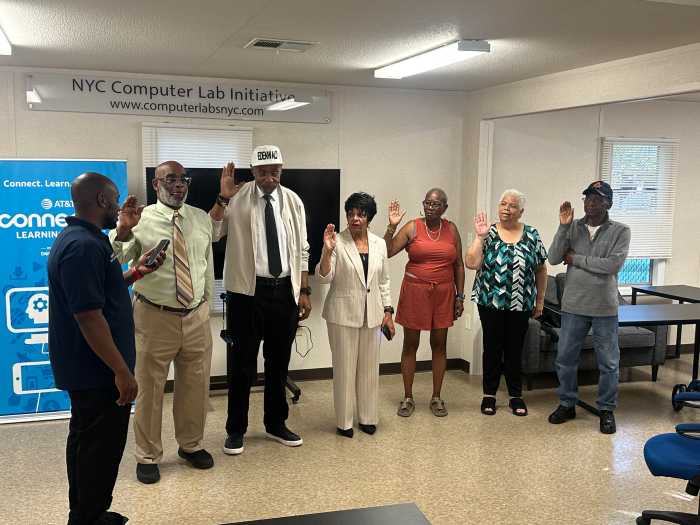Andréa Burns in “On Your Feet.” | MATTHEW MURPHY
BY DAVID NOH | The always cozy and enjoyable New Dramatists Annual Spring Luncheon at the Marriott on May 12 rightly honored a radiant Audra McDonald who is currently giving a triple threat performance in “Shuffle Along” that — even pregnant, while tapping away — is by any standard great. The fact that she has won six deserved Tonys means that awards count for something, but the snub of her this year, nomination-wise — as if she’s had enough already — means that they can be meaningless, too.
Theater stars were in the usual abundance at the Marriott — and wonderfully accessible. I saw Jennifer Simard, who I’ve been beating the drum for since first seeing her genius comic performance in “Disaster,” and I call her the “People’s Princess Tony Nominee.” She learned of her nomination “in Cold Springs, where I was with my husband. We were down by the water, sitting in a gazebo, and we were hugging and kissing and telling one another how much we loved each other. Our show closed Sunday, but that doesn’t take way the joy we had doing it.
“What am I doing now? I’m taking my husband to many fancy dinners to thank him for all the sacrifices he made for me. Of course, things will pop up, but I’m just enjoying the ride.”
In the Noh: New Dramatists Annual Spring Luncheon and a Margaret Sullavan feast at MoMA
With her ravishing, face-splitting smile, Andréa Burns’ beauty reminds me of the gorgeous polyglot women I grew up with in Hawaii. As Gloria Estefan’s mother in the delicious “On Your Feet,” she skillfully plays a difficult, disapproving character who has one moment of glory, recreating her Havana nightclub act just before Castro took over. As staged by a brilliant Jerry Mitchell and choreographer Sergio Trujillo, it’s the most the most exciting number on Broadway, sizzlingly glamorous and emotionally devastating.
Of her part in “On Your Feet,” Burns told me, “Yes, she is like a Bette Davis kind of role, as you say, absolutely, a great character. I think the mother-daughter — in a first generation, stateside — situation is huge. I’ve had the experience of being on the daughter’s side of that, but it’s actually quite beautiful to stand in my mother’s shoes, who had the experience of coming to another country and trying to instill the values of the place that she came from, what’s important to my culture, while still trying to remain relevant.
Jennifer Simard with David Noh at the May 12 New Dramatists Annual Spring Luncheon. | COURTESY: DAVID NOH
“I’m very moved by the story of Gloria Fejardo — what an incredible lady, 86 years old today and still quite strong and powerful. Gloria Estefan’s daughter, Emily, is quite a fantastic musician and she wrote the song in the hospital scene, the only original song in the show. This daughter was born after her mother’s bus accident when they told her she couldn’t have kids again. So she’s a miracle baby who just graduated from Berklee College of Music. She makes these rap videos with her grandmother improvising raps in Spanish. She’s a whole other musical, a star in her own right.”
I had been unfamiliar with Burns’ song in the show, “Mi Tierra,” and she explained, “It’s a huge anthem in Latin America. It was on Gloria Estefan’s first Spanish album and speaks about leaving your homeland, but no matter where you go it always has a pull on you that can’t let you go. You feel that undertow.
“I love that you didn’t know the song and felt so connected, not being a Spanish speaker. For Latin people who know it already, it’s a very emotional song. In the show she first sings it to be entertaining [in the nightclub], but the lyrics are very real to her and it goes to a more powerfully dramatic and emotional place. Jerry and Sergio did fabulous work on this, but I also have to give a lot of credit to Maria Torres, the associate choreographer. She’s a salsa champion and really helped me get into that body of a Latin floorshow performer. She was my mentor all the way.”
Like me, Burns has never been to Cuba and is dying to go now: “I am from Miami originally, so although my mom is Venezuelan, I always say I have a Cuban heart, having grown up with all the culture, music, and food. I’m one of the few Venezuelans on Broadway.”New
Married, with a 12-year-old son, Burns took the high road when I decried the idiotic Tony nominators who snubbed her show save one nomination for Trujillo’s choreography.
“It’s a very packed season with lots of excellent performances and only five spots. What are you going to do?,” she said.
There seemed to me to be a certain whiff of racism in the snub, as well. Although it doesn’t bludgeon you — albeit brilliantly — as “Hamilton” does, it is just as much about race, with the Estefans in the early days constantly struggling with stereotyped limitations put upon them by the music business. But, with Latin issues, as well as with Asians, I feel the mostly white judges of all these end-of-season award organizations are pretty blind to any color issue, save black — plus the added factor of maybe not being all that into Estefan’s music.
Burns praised her book writer, Alexander Dinelaris: “That was very upsetting. Alex is an Oscar winner, a terrific writer who breathed so much grounding depth into our show made from a catalogue of pre-existing music. He’s the one who connected them all together. And, yes, the audience cheers every single night when Josh Segarra [as Emilio Estefan] says, ‘This is the face of an American.’
“But I feel very loved. There was so much outreach the day the nominations came out. So many people I love in our community said, ‘What happened? This is unexpected! I was really rooting for you!’ In a way, that was really worthwhile. It’s easy to call people on the day of good news but it’s really nice to know when there’s not good news how many people go to bat for you. Ben Brantley just wrote this thing in the Times about who should have been nominated and very kindly singled myself out, and the show in a lot of categories. I was so delighted to see that and it made me feel the community has not moved on without us and we’re still — even in this Tony season — very present.”
I wanted to know if two other Latin diva powerhouses, Chita Rivera and Rita Moreno, had seen the show. “Rita has been a couple of times. She came to see ‘In the Heights’ and said, “You remind me of a young me!’ Which was fabulous. She came to our first preview in Chicago as she’s very close to the Estefans, and also a couple of times to our later previews.
“I finally said, ‘Look, Rita, I need your notes because I’m basically playing you.’ ‘No! No, mija [sweetheart]! No notes! Fabulous! You were fabulous.’ Meanwhile I would have taken six pages from her, but to me that means the world to have that kind of affirmation. I’m not sure if Chita has come, but I’m dying for her to see it.”
Andrea Burns is in “On Your Feet” through October 5. Do not miss her.
MoMA is presenting a wonderful series: “Universal Pictures: Restorations and Rediscoveries, 1928-1937” (11 W. 53rd St., through Jun. 15; moma.org/calendar/film/1642). Primarily known historically as the house of horror in the 1930s, it boasted a formidable leading lady in its ranks, my favorite movie actress, Margaret Sullavan. Like my other favorite, Vivien Leigh, her radiant talent was limited to far too few films, but, for a few years, she dazzled critics and audiences with her wistful yet forthrightly intelligent presence, imperfect (weak chin, too long upper lip) but compelling beauty, and that voice — a thrillingly husky marvel that could creep into the very depths of your soul.
Margaret Sullavan in “The Good Fairy,” which screens at MoMA on June 4. | MOMA.ORG
“The Good Fairy” (Jun. 4, 5 p.m.) is the best of her Universal lot, and why shouldn’t it be, brilliantly adapted by Preston Sturges from a Ferenc Molnár charmer of a play that had starred Helen Hayes — who greatly admired Sullavan — on Broadway, and elegantly directed by William Wyler, who fought with her on set and then married her (briefly, after her divorce from Henry Fonda). In Sullavan’s entrancingly innocent, gamine performance, you see the roots of practically the entire career of Audrey Hepburn.
“Little Man, What Now” is directed by that master of down-trodden romance among the sweet losers of the world, Frank Borzage, and takes place in a just pre-Nazi Germany. It features Sullavan as an adorable young wife of struggling Douglass Montgomery, one of the more fey — if talented — Hollywood juveniles. No one could make poverty as picturesque or so damned appealing as she — and Borzage — in something like this.
“Only Yesterday” (May 30, 4 p.m.; Jun. 12, 2:30 p.m.), an intelligent and sensitive John Stahl-directed weepie, was Sullavan’s 1933 screen debut, in which the plaudits she received universally took some of the thunder away from her contemporary and great lifelong rival, Katharine Hepburn, another jeans-wearing, non-conformist of a seriously committed actress. (Hepburn once admitted to purposely snatching roles she wasn’t interested in, like “The Little Minister,” just so another actress couldn’t do them, and I swear she must have meant Sullavan.)
In her 1936 Paramount film, “The Moon’s Our Home,” Sullavan even did a comically bitchy Hepburn takeoff in the role of a temperamental movie queen. Their combative paths kept crossing, with the two of them sharing stage mentors (and perhaps lovers) in the diabolical genius Jed Harris, who loathed Hepburn but loved Sullavan. The prominent Hollywood agent Leland Hayward actually dated both of them simultaneously, with Sullavan eventually winning out when he married her, something that came as a complete shock to Hepburn when she heard about it on the radio.
Sullavan’s daughter, Brooke Hayward, wrote the memoir “Haywire,” which is the enlightening and harrowing best account of her, as well as one of the best books about Hollywood. I’d advise pilgrimages to MoMA to experience the utter, ineffable magic of a woman who was both Louise Brooks’ and Stephen Sondheim’s favorite actress. “She always seemed to be dying,” Sondheim once observed, which she did in 1960, a suicide.




